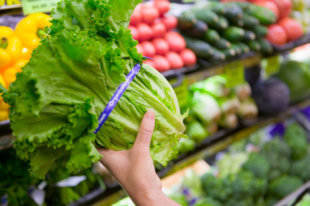
Food prices are on the rise, and 18 percent of families in the United States say that they can't afford to buy the food they need. Yet the average American family of four throws away 40 percent of the food they purchase -- as much as 20 pounds of food per person per month, a new report says -- and spends $2,275 a year on food they never end up eating.
It adds up to a staggering $165 billion worth of wasted food each year, the Natural Resources Defense Council says in their new report,"Wasted, How America Is Losing Up to 40 Percent of Its Food from Farm to Fork to Landfill." Just reducing that amount by 15 percent would feed more than 25 million Americans.
Related: The best healthy foods to buy on a tight budget
"We spend so much energy looking at sustainable agriculture," Dana Gunders, a project scientist in the food and agriculture program at the National Resources Defense Council and the report's lead author, told Yahoo! Shine in an interview on Wednesday. "To think that almost half of that food is actually not getting eaten, it's just such a waste of our resources."
Thanks to super-sized portions and our preference for perfect-looking produce, the average American wastes 10 times as much food as somebody in Southeast Asia -- that's a 50 percent increase in the amount of food wasted since the 1970s. Some of that wasted food never even makes it home; we're so used to seeing a huge variety of fruits and vegetables at the supermarket that stores can't sell it all before it goes rotten.
Related: 5 clever ways not to waste food
"With apples, a lot of the ugly ones go to juice or applesauce," Gunders explains. "But cucumbers? There's not much else you can do with bent cucumbers that are perfectly fine, but just bent." Those end up in landfills.
When produce prices are too low, farmers can't recover the cost of harvesting food, so they actually leave entire fields unharvested. During one of the country's worst droughts, and with accessibility to fresh fruits and vegetables still difficult in poorer communities, "It's really sad to know that there are fields of fresh food that are just being turned under," she says. "I don't see any reason why we should not be looking at this as a key opportunity for the United States' food system to become more efficient."
For consumers, the first step can start right at home.
- Shop wisely. Plan out what you want to buy before you go to the grocery store, so you don't end up buying more than you'll actually use, Gunders suggests. Much of the 40 percent of food we throw out simply goes bad before we have a chance to eat it.
- Cook wisely. Don't cook more than you can reasonably eat in a given time, and be sure to include leftovers in your calculations.
- Understand expiration dates. Those dates on most pre-packaged products isn't really an expiration date, it's a "use-by" date. "A lot of people see that date and throw the food out right after," Gunders says, but most of them are not meant to indicate the safety of the food. "They're not federally regulated," she points out. In many cases, "they just indicate peak quality." According to the U.S. Food and Drug Administration, the date is there to help stores decide how long to display the product, and to help consumers know when the product is best to eat. "It is not a safety date," the U.S. Department of Agriculture, which regulates food safety, states on its website. "After the date passes, while not of best quality, the product should still be safe if handled properly and kept at 40 degrees F or below for the recommended storage times." (You can find those recommendations here.)
- Use your freezer. Many foods can be safely frozen, Gunders explains, including staples like bread and milk. Homemade foods, like mashed potatoes and cooked meats, can also be frozen, allowing you to use up your leftovers at a later date.
- Watch what you order when dining out. Jumbo-size meals in restaurants lead plenty of people to leave food on their plates, and that food ends up in landfills. "Our food waste has increased about 50 percent since the mid-'70s," Gunders says. "Along a similar timeline, dinner plates have increased their diameter by over 30 percent."
- Understand portion sizes. The average cookie has quadrupled in size since the mid-'80s, the average service of soda has gone from 7 ounces to 42 ounces since the 1950s, and recipes in "The Joy of Cooking" have an average of 30 percent more calories than they did in 1996. Portion sizes "are just bigger, or the recipe serves fewer people" than it did in previous editions, Gunders says. (You can find a guide to healthy portion sizes here.)
"I do believe that a little bit of awareness can go a long way on this issue," Gunders says. "I think that there's a real opportunity here for all of us, individually and collectively, to reduce our environmental footprint and save money, and even help feed others without a whole lot of sacrifice."
Copyright © 2012 Yahoo Inc.
5 comments:
Restaurants, school cafeteria's, super markets, hospitals, USDA farm purchases and all governmental agencies waste billions of dollars of food every year at everyones expense.
na wa nuthg we know go see or hear why waste such an amount..while hunger dem sm places..its well
this is so crazyyyyyyyyyyyyyyyyyyyyyyyyyy oooooooooooooooooooooooooooooooooooooooo..see figure ooooo..no comment..
Everyone's right.
So let's stop wasting food oooooooooooooooooooooooooooooooooooooooooooooooo..
It is such a shame to see food thrown away when there are so many homeless and people who go hungry in this country.....
Post a Comment